Long-time Silk Road oasis refurbished by Uzbekistan’s national hero, Tamerlane, has some fabulous architecture, but lacks the magic
We took the train, from Bukhara to Samarkand, very comfortable, three hours, piece of cake, really. One departs from a vokzal, the same in the entire former Soviet Union, the word derived from Vauxhall, which was the London station visited by two Russian engineers in the 19th Century, who took the name for a generic, and so introduced it in the Russian language. Taxi into town, the price negotiated down to, according to the driver, “the price of a cup of coffee” (hard to believe that anybody in this country would pay $5 for a coffee), and, with some difficulty, found ourselves accommodation in one of the old courtyard houses – the few of them that have not been bulldozed down. Easy walking distance from the monuments that make this town so famous.
Samarkand is quite different from Khiva and Bukhara, in that there is not much of an old town left, and the monuments one comes to see are really stand-alone pieces, in a park area lined with tourist shops. But stand-alone pieces they are, even if there are comparitively few. The best-known is the Registan, with two enormous madrasses and a mosque, all extensively decorated with majolica tiling – the characteristic blue and turquoise that you have also seen from Khiva and Bukhara. This is followed by the Bibi Khanum mosque, possibly even bigger than the Registan buildings. Photos show this complex to be largely in ruins in the 1960s, but from 1980 to 1996 UNESCO-led restoration has been undertaken, with phenomenal results, very tasteful, in a way you could actually imagine that it looked like this around 1400, when it was first constructed. A little further on is the Shah-i-Zinda, a truly impressive collection of 14th and 15th Century mausoleums, unique in that these, unlike the other monuments, are still largely original. A densely packed narrow path is flanked by mausoleums on both sides, the one even more extravagantly decorated than the other, both on the outside and the inside. These were all Tamerlane relatives and close associates (one of the most opulent tombs is, allegedly, for Tamerlane’s wet-nurse!). And Tamerlane himself – he, his spiritual adviser, some of his children and his grandson – is buried in the Gur Emir, another riot of gold and blue majolica, topped by a rippled dome.
With Tamerlane – the Anglicised version of Timur the Lame – I have mentioned Mr. Samarkand. A powerful and rich city already existed here in antiquity, as Marakanda, conquered by Alexander the Great in 329 BC. It was important on the original Silk Road during Roman times, it was besieged and taken by the Arabs in 712, and it was sacked and plundered by Ghengis Khan in 1220. Yet, every time the city resurrected itself again, and Marco Polo and Ibn Battuta commented on this large and splendid city in the 13th Century, less than a 100 years after the Ghengis Khan visit.
But it was Tamerlane, who came to power at the end of the 14th Century, who turned the city into something not seen before in Central Asia, or indeed the Muslim world. Which was kind of funny, because Tamerlane was quite adept at destroying everything else on his campaigns, that stretched from India and China to Turkey and deep into Russia. As so often, however, family power withers afterwards, and Tamerlane’s dynasty gradually lost control over the empire, and was ultimately absorbed by Bukhara in the 16th Century, and by Tsarist Russia in the 19th Century.
Since independence, Tamerlane, or Amir Timur, as he is known here, has gained status again, and is now regarded as the national hero of Uzbekistan, remarkable for someone who was not an ethnic Uzbek, and killed many Uzbeks in his campaigns. On top of that, the guy may have been a brilliant strategist, but he was mostly an absolute barbarian, with a rather unusual foreign affairs policy and little time for dialogue. It is hard to see the Germans erecting statues for Hitler in 500 years’ time, yet, something like that is happening here. Timur is everywhere, on a pedestal.
Anyhow, back to Samarkand, that, thanks to Timur, and UNESCO, has once again developed into the prime tourist attraction of Central Asia. And it shows, not only in monuments but also in tourist infrastructure. The zone around the monuments has been cleared of anything untidy, like local houses, for instance – a wall hides the crumbling houses near Gur Emir from sight -, and in its stead are wide walking lanes, lined with restaurants and souvenir shops. Inside the monuments, more souvenir shops, in every corner of the madrasses, along the walls of the mosques, even in underground catacombs of the Tamerlane mausoleum. And the sellers are a lot more persistent, again. Curiously, despite all of this, Samarkand is actually poorly equipped with restaurants; one evening we walked for well over half an hour in search of food, only to settle for the local version of KFC, and the next evening we ended up in a somewhat obscure Russian restaurant with even obscurer, loud, live music. You can’t win them all
In order to get some variety – how many blue and turquoise tiles can you see, after all? – we turned into the bazaar, behind the Bibi Khanum mosque. Great atmosphere, lots of colour, lots of smells – cumin, and pink basil, next to the ever-present coriander and dille -, stacks of the traditional round breads that are so common here. The people perhaps slightly less forthcoming than in other parts we have been to so far in Uzbekistan, but this could be a function of the amount of tourist that show up on an average day, generally poor customers that block the narrow paths between stalls with their cameras.
Further away from the monuments, Samarkand is actually mostly a Soviet-designed city. Wide avenues flanked by trees, big squares and parks full of fountains. Which is not unpleasant for an afternoon walk, albeit rather uneventful. There is an old theatre, somewhat dilapidated, and old hotel, which got a partial facelift, but its surrounding grounds are falling apart, too. Some of the newer buildings, government offices obviously, are huge, way bigger even than the Bibi Khanum mosque. But in design they are somewhat less creative, perhaps.
Which leaves one with the impression that, yes, Samarkand is a great place to visit, with definitely the most impressive monuments we have seen so far, but it lacks the magic of Khiva or Bukhara.
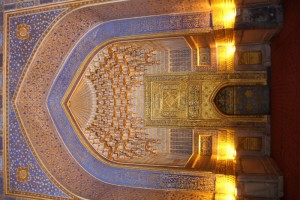
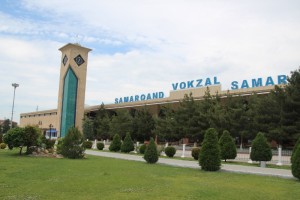


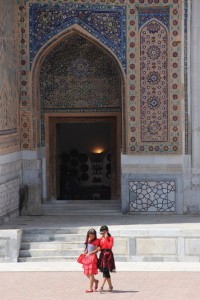

















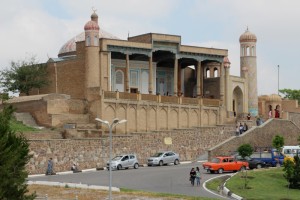


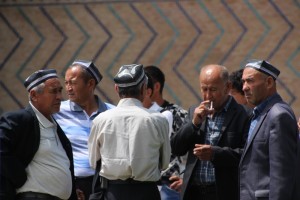
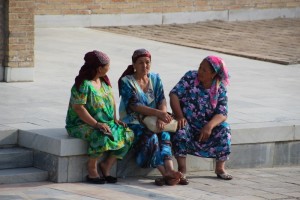


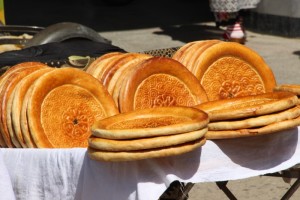
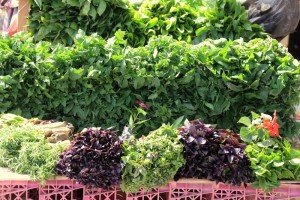
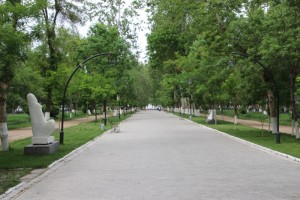
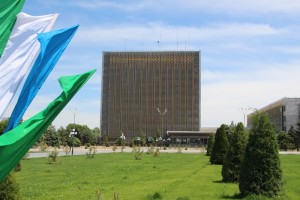











The mosque is stunning, Pak Bruno.. I noticed that many mosques in Turkey is also dominated by turquoise colors. I need to check if it’s also influenced by Turkish’s style in glory time of Ottoman. Samarkand looks beautiful. But, with 5 dollars for a cup of coffee, the city is a bit expensive..
don’t worry, the 5$ was just a taxi driver complaining, Samarkand is not very expensive. And there are no doubt connections with and influences from Turkey. Regards, Bruno
Hoi hoi,
Leuk om jullie reisverslagen te lezen! Interessante plekken die voor mij (en wellicht de rest van de wereld) onbekend zullen zijn. Omdat dit zo weinig toeristisch is, lijkt me het reizen niet heel makkelijk. Ik krijg de indruk dat jullie ervaringen daar niet voelen als een warm bad. Klopt dat?
Ik hoop dat jullie een goede tijd daar hebben en wens jullie nog mooie avonturen toe!
groeten, mede namens Mijke,
Rubin
(Oet Diem)
Ha guys, leuk dat jullie het leuk vinden, daar doen we het uiteindelijk ook een beetje voor! En weet je, de realiteit is dat we zelden zo makkelijk gereisd hebben, eergistern pas voor het eerst in een bus gezeten. Taxis en shared taxis gaan overal heen, en zijn ongelofelijk goedkoop. Blijf terugkomen! Groet, Bruno